How to Grow Broccoli
This post may contain affiliate links, which means that I may receive a commission if you make a purchase using these links. As an Amazon Associate I earn from qualifying purchases.
Want to grow your own nutritious broccoli? Our guide can help you from sowing to harvesting and preserving it too. Learn tips for growing broccoli in your own backyard vegetable garden.
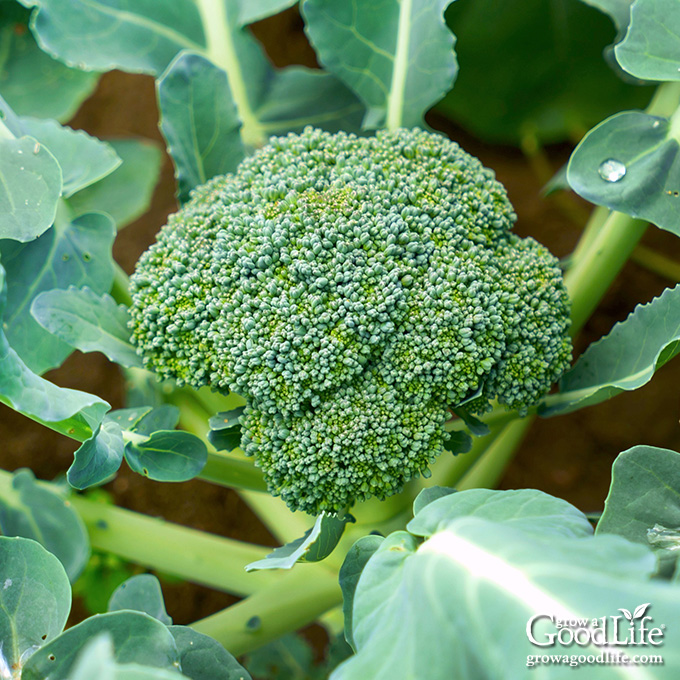
Broccoli, with its vibrant green florets and rich nutritional profile, is a vegetable that both gardeners and food enthusiasts can enjoy. Whether you’re a health-conscious individual looking to incorporate nutrient-dense foods into your diet or an avid gardener seeking a rewarding and versatile crop, growing broccoli offers a multitude of benefits.
Not only is broccoli packed with vitamins, minerals, and antioxidants, but it is also remarkably easy to grow in your own backyard. By learning the basics of growing broccoli, you can enjoy a delicious harvest of this delicious and wholesome vegetable.
In this guide, we will explore the ins and outs of growing broccoli, from selecting the right varieties to starting seeds, caring for your plants, and knowing when to harvest, ensuring a successful crop that will grace your dinner table with fresh flavors and nourishing goodness.
About Broccoli
Broccoli (Brassica oleracea var. italica) belongs to the cruciferous vegetable family, which includes cabbage, cauliflower, and kale. This cool-season crop is known for its striking appearance, consisting of a compact head of clustered florets attached to a thick, edible stalk.
The florets, which are typically dark green in color, form a rounded shape, sometimes referred to as a “broccoli head” or “curd.” Broccoli plants can reach a height of around 2 to 3 feet and exhibit lush, deeply-lobed leaves.
Besides its appealing appearance, broccoli is a nutritional powerhouse packed with vitamins, minerals, dietary fiber, and antioxidants.
Originating from the Mediterranean region, broccoli has a fascinating history. It is believed to have been cultivated for thousands of years, with records of its consumption dating back to ancient Roman times.
Broccoli gained popularity in Italy during the 16th century and gradually spread to other parts of Europe and eventually to the United States. Today, it is widely cultivated across the globe and has become a staple in many cuisines due to its versatility and remarkable health benefits.
Broccoli Varieties to Consider Growing
When it comes to growing broccoli, there are several popular and recommended varieties to choose from. Each variety has its own unique characteristics, taste, and suitability for different climates. Here are some of the most common types of broccoli you might consider growing:
- Batavia Broccoli, also known as Italian broccoli, is an heirloom variety with large heads and thick, tender stalks. It has a slightly sweet and mild flavor, making it a favorite for both raw consumption and cooking. Batavia broccoli is versatile and performs well in a variety of climates, but it tends to thrive in cooler temperatures.
- Belstar Broccoli is a hybrid variety known for its early maturity and uniform, dome-shaped heads. It has a dense texture and a mild, slightly sweet flavor. Belstar is an excellent choice for gardeners in cooler regions, as it is highly resistant to cold temperatures and frost.
- Covina Broccoli is a popular broccoli variety that produces medium-sized heads with tightly-packed florets. It has a slightly bitter taste, which intensifies when cooked, making it a great option for steaming, stir-frying, or roasting. Covina is well-suited for growing in various climates, including both moderate and cooler regions.
- De Cicco Broccoli is an heirloom variety that produces smaller heads with a longer harvest window. It has a mild flavor and tender stalks, making it ideal for fresh eating and freezing. De Cicco is relatively adaptable and can be grown in various climates, including areas with shorter growing seasons.
- Fiesta Broccoli is a hybrid variety with medium-sized heads that exhibit a beautiful green coloration. It has a mild and slightly sweet flavor, making it appealing for raw consumption or lightly cooked dishes. Fiesta is well-suited for growing in regions with moderate temperatures and can tolerate some heat.
- Waltham Broccoli is a popular open-pollinated variety known for its large, blue-green heads and abundant side shoots. It has a hearty and slightly sweet taste, making it a versatile option for various culinary uses. Waltham performs well in cooler climates and is highly tolerant of temperature fluctuations.
These are just a few examples of the many broccoli varieties available. Consider your climate, taste preferences, and intended use when selecting the right variety for your growing conditions. Feel free to explore your local nurseries or seed catalogs for additional broccoli varieties that may be better suited to your specific region.
Tips for Growing Broccoli
Successfully growing broccoli requires attention to soil preparation, sunlight, temperature, spacing, and companion planting. Follow these tips to optimize your plants’ growth and ensure a bountiful harvest.
When to Grow
Broccoli is a cool-season crop that grows best in the cool temperatures in early- to mid-spring for an early summer harvest or in mid- to late summer for a fall crop, depending on your specific climate.
For both spring and fall plantings, you have the option to start broccoli seeds indoors or sow them directly outdoors:
- Spring plantings: Start seeds indoors approximately 6 to 8 weeks before the last frost date in your region. Or direct sow seeds outdoors approximately 2 to 3 weeks before the last expected frost date or as soon as the soil can be worked in the spring.
- Fall plantings: Start seeds indoors or direct sow seeds outdoors in midsummer, about 85 to 100 days before your first expected fall frost date. Summer planting outdoors can be challenging in hot regions, but by providing shade and ample moisture, you can still grow healthy plants that will form heads when the cooler weather arrives in fall.
I love growing broccoli in the fall because there seems to be less pest pressure. I start broccoli seeds indoors under lights in my cool basement in summer, and the seedlings are transplanted to the garden at the end of August, covered with a row cover to protect the plants from pests, and then harvested before hard frost. Broccoli thrives in cool weather, and can tolerate light frosts. Like other cole crops, the flavor sweetens after the plants experience a light frost.
By following these planting timeframes and considering your specific climate conditions, you can maximize your chances of success and obtain a plentiful harvest of fresh, homegrown broccoli. You can learn more about developing a planting calendar in this article: How to Make a Seed Starting Schedule.
Site Selection and Soil Preparation
Broccoli grows best in full sun for optimal growth and head development. Choose a bright location with 8 to 10 hours of direct sunlight for early spring planting.
However, broccoli will also grow in partial shade in as little as 6 hours of sunlight daily. As a cool-season plant, broccoli grows slowly, and partial shade can slow down the plant’s blooming process, enabling more time for the broccoli heads to develop. Lower sunlight can make the broccoli grow taller and thinner, with smaller heads, but it will still taste delicious. You can learn more about growing crops in shady spots in the following article: Vegetables that Grow in Shade.
Broccoli thrives in well-draining, fertile soil. Aim for a slightly acidic to neutral soil pH ranging from 6.0 to 7.0. Amend the soil with organic matter, such as finished compost or well-rotted manure, to improve its nutrient content and drainage.
When choosing an area to plant broccoli, also consider implementing crop rotation practices. Crop rotation involves the movement of different plant families from one area of the garden to another each growing season. This helps prevent the buildup of pests and diseases that specifically target certain plants.
Avoid planting broccoli or any other cruciferous vegetables, such as cabbage or cauliflower, in the same spot year after year. Rotate them with unrelated plants, such as beans or root crops, to help maintain the health of the soil and reduce the risk of pest and disease problems. A well-planned crop rotation schedule can contribute to your garden’s long-term success and sustainability. You can learn more in the following article: Benefits of Crop Rotation for Your Vegetable Garden.
Planting Broccoli
This section explores the detailed process of planting broccoli, including starting seeds indoors under lights, directly sowing seeds in the garden, and transplanting seedlings.
Sowing Seeds Indoors Under Lights
For more information on using grow lights and starting seeds indoors, check out the articles “Using Grow Lights for Starting Seeds” and “10 Steps to Start Seeds Indoors.” Then follow these steps:
- Fill seed-starting trays or small pots with a high-quality seed-starting mix.
- Sow broccoli seeds about 1/4 inch (0.6 centimeters) deep in each cell or pot, placing one or two seeds per cell.
- Keep the soil consistently moist but not waterlogged. Using a spray bottle or a gentle watering technique can help prevent disturbing the seeds.
- Place the trays or pots under grow lights or in a sunny location with temperatures between 70°F and 80°F (21°C to 27°C) for optimal germination.
Once the seedlings have developed a few sets of true leaves and the danger of frost has passed, transplant hardened off broccoli seedlings into the garden.
Transplanting Seedlings
Whether you grow your own seedlings or purchase plant starts at a garden nursery, they will need to be hardened off. Check out this article to learn How to Harden Off Seedlings. Then follow these steps to plant your broccoli seedlings:
- Choose a well-prepared garden bed with fertile, well-draining soil. Prepare the bed by incorporating compost or well-rotted manure.
- Dig holes in the garden that are slightly larger than the root ball of each seedling.
- Gently remove the seedlings from their containers, being careful not to disturb the roots. Place each seedling in a hole and fill it in with soil, firming gently around the base.
- Space the transplants according to the recommended spacing, typically 18 to 24 inches (45 to 60 centimeters) apart in rows with 24 to 36 inches (60 to 90 centimeters) between rows.
- Water the transplanted seedlings thoroughly after planting to help them establish in their new location.
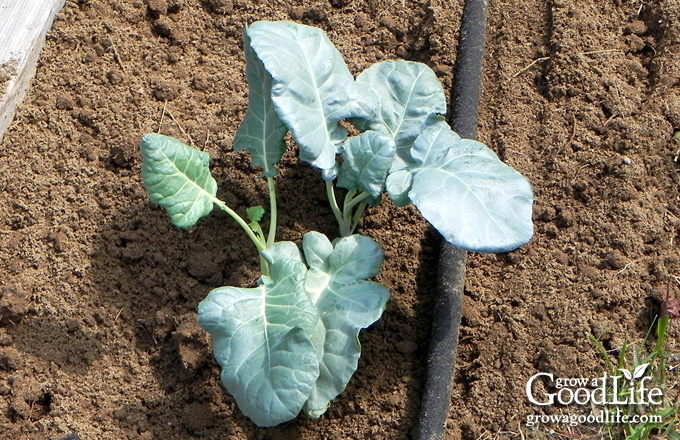
Direct Sowing Seeds
Direct seeding broccoli is a convenient way of growing this nutritious vegetable. In fact, it can be much easier than caring for seedlings, hardening off, and transplanting. By following these guidelines, you can successfully grow broccoli from direct-sown seeds:
- Prepare the garden bed by loosening the soil and removing any weeds or debris. Ensure the soil is well-drained and enriched with organic matter.
- Sow broccoli seeds directly in the garden, planting them about 1/2 inch (1.3 centimeters) deep in rows with the recommended spacing.
- Cover the seeds with soil and gently firm the surface to ensure good seed-to-soil contact.
- Water the soil gently after sowing to provide moisture for germination.
- As the seedlings emerge and grow, thin them to the desired spacing, typically 18 to 24 inches (45 to 60 centimeters) apart.
Regardless of the method you choose, ensure the seedlings or direct-sown plants receive regular water, protection from pests, and appropriate care as they grow. We will cover these aspects in detail in the upcoming sections of this guide.
How to Care for Broccoli
Proper care will help grow strong and healthy plants that will produce a bountiful harvest. Let’s delve into the basics of caring for your broccoli plants:
- Watering: Broccoli requires consistent moisture to thrive, but it’s important to strike a balance to prevent overwatering or underwatering. Water deeply, aiming for about 1 inch (2.5 centimeters) of water per week, either from rainfall or irrigation. Monitor the soil moisture and adjust the watering frequency depending on the weather conditions. Avoid allowing the soil to become excessively dry or soggy.
- Weeding: Keep the broccoli bed free from weeds, as they compete for nutrients, water, and sunlight. Regularly remove weeds by hand or use appropriate gardening tools to minimize weed growth. Mulching the soil around the broccoli plants can help suppress weed growth and retain soil moisture.
- Mulching: Apply a layer of organic mulch, such as straw, shredded leaves, or grass clippings, around the base of the broccoli plants. Mulching helps conserve soil moisture, regulate soil temperature, suppress weed growth, and improve overall plant health.
- Fertilizing: Before planting, amend the soil with compost or well-rotted manure to provide organic matter and nutrients. Additionally, side-dressing with a balanced organic fertilizer or additional compost during the growing season will give the plants a boost. Avoid over-fertilizing with nitrogen-rich fertilizers, as it may promote excessive foliage growth at the expense of head development.
Common Pests and Diseases
Broccoli plants can be susceptible to various pests and diseases. By being aware of these common issues, you can promptly identify and address them to minimize damage. Here are some common pests and diseases that affect broccoli plants:
- Cabbage worms are the larvae of cabbage white butterflies. They feed on the leaves and heads of broccoli plants, causing holes and damage. Use row covers to prevent the butterflies from laying eggs on your plants. Look for green caterpillars on the undersides of leaves. Handpicking the larvae or applying organic insecticides like Bacillus thuringiensis (Bt) can help control cabbage worms.
- Aphids are small, soft-bodied insects that suck sap from the leaves, causing stunted growth and distorted foliage. Rinse off aphids with a strong spray of water or use insecticidal soap to control infestations. Attracting natural predators like ladybugs can also help keep aphids in check.
- Cabbage loopers are the larvae of moths. They chew irregular holes in the leaves and can be identified by their looping movement. Handpicking or using organic insecticides can help control cabbage loopers. Row covers can also effectively prevent adult moths from laying eggs on the plants.
- Flea beetles are small jumping beetles that feed on the leaves, resulting in tiny holes. Protect young seedlings from flea beetles by using floating row covers.
- Slugs and snails are nocturnal pests that feed on young broccoli plants, leaving behind large irregular holes in the leaves. Handpicking, using traps, or applying organic slug and snail baits can help control their population. Creating barriers like copper tape or diatomaceous earth around the plants can also deter them.
- Clubroot is a soil-borne disease caused by a fungus-like organism. It causes swollen, distorted roots and stunted growth. Practice crop rotation, ensure good soil drainage, and use resistant varieties to prevent clubroot. Avoid planting broccoli in areas with a history of clubroot.
- Black leg is a bacterial disease that results in dark, sunken lesions on the stems. These lesions expand and cause wilting or dieback of the affected areas. Implementing preventive measures such as selecting disease-resistant varieties, practicing crop rotation, and maintaining good garden hygiene can help manage black leg and reduce its impact on your broccoli crop.
- Black rot is a bacterial disease that affects the leaves and heads of broccoli plants. It causes V-shaped lesions on the leaves and can lead to rotting of the heads. Remove and destroy infected plants to prevent the spread of the disease. Practice good sanitation and avoid overhead watering to minimize its occurrence.
- Downy mildew is a fungal disease that appears as yellow patches on the upper surface of leaves and a fuzzy grayish-white growth on the undersides. Plant broccoli in well-ventilated areas with good air circulation and avoid overhead watering. Apply organic fungicides if necessary.
- Powdery mildew is a fungal disease that forms a white powdery coating on the leaves. It can cause leaf curling and stunted growth. Plant broccoli in areas with good air circulation and space the plants adequately. Remove infected leaves and apply organic fungicides if needed.
Pest Protection Strategies
Protecting your broccoli plants from common pests can be a challenge. Here are some strategies for pest protection:
- Companion Planting: Interplanting broccoli with companion plants that repel pests can provide natural pest control. Examples include planting herbs like dill, rosemary, or thyme nearby. Marigolds and nasturtiums are known to deter certain pests when planted close to broccoli.
- Physical Barriers: Use physical barriers such as row covers or netting to prevent pests like cabbage worms or aphids from reaching your broccoli plants. These barriers create a physical barrier between the pests and the plants, reducing the likelihood of infestation.
- Organic Pest Control: Employ organic pest control methods like insecticidal soaps, neem oil, or horticultural oils to target specific pest issues. Regularly monitor your plants for signs of pest activity, and take appropriate action as needed.
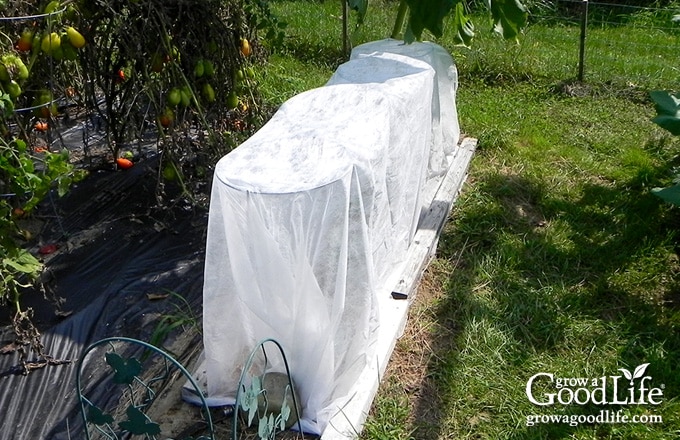
When and How to Harvest Broccoli
It is important to harvest broccoli at the right time for optimal flavor, texture, and nutrients. This means harvesting when the central head is fully developed with tightly formed buds, but before yellow flowers bloom.
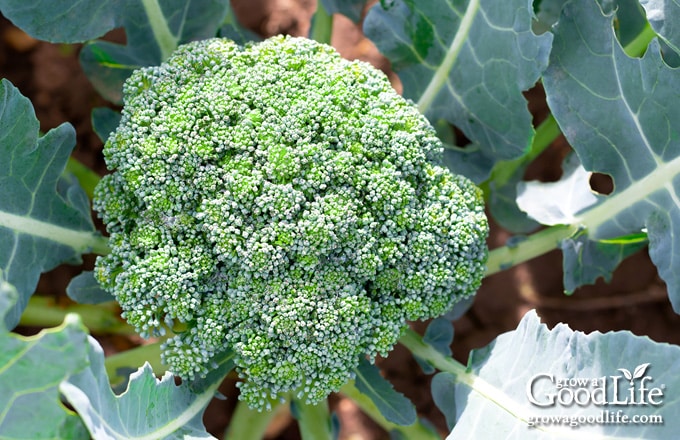
Harvesting Broccoli
Harvesting broccoli not only involves the central head but also extends to other parts of the plant. Broccoli is known for its versatility, and all its parts, including the leaves and stems, are edible and offer unique flavors and textures. Here’s how you can make the most of your broccoli harvest:
Broccoli Heads and Side Shoots
Regularly check the plants for readiness and harvest as soon as the heads reach the desired size and density, typically around 4 to 8 inches (10 to 20 centimeters) in diameter, depending on the variety. The timing will vary depending on the broccoli variety and growing conditions. Typically, heads are ready for harvest around 60 to 85 days after transplanting or 70 to 100 days after sowing seeds.
The heads will bolt or blossom into yellow flowers if you wait too long. While broccoli flowers are edible, they do turn bitter.
Use a sharp knife or garden shears to cut the central head about 5 to 6 inches (13 to 15 centimeters) below the head, taking care not to damage nearby developing shoots.
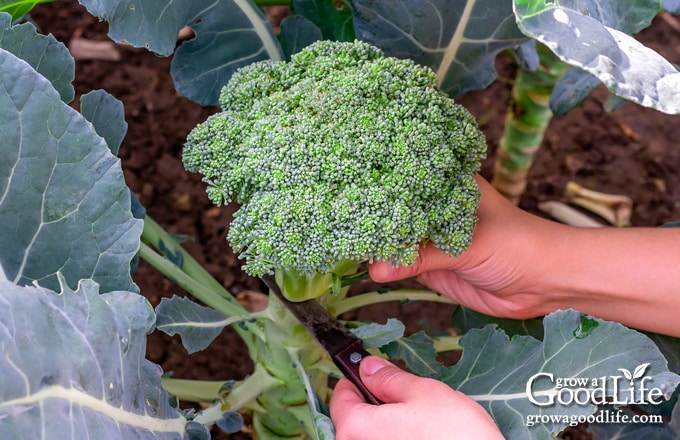
After the main broccoli head is harvested, the plants often produce smaller side shoots or florets. Let these grow and harvest the side shoots once they size up a bit, ensuring they are still tight and compact.
Edible Leaves and Stems
The leaves of the broccoli plant are tender and have a slightly milder flavor than the central head. Harvest individual leaves as needed and use them as a nutritious addition to salads, sauté them with garlic and olive oil, or incorporate them into soups and stews.
The stems of broccoli are often overlooked but are just as delicious. Peel the tough outer skin and slice the tender inner part to use in stir-fries, soups, or as a crunchy addition to salads.
Storing Broccoli
Immediately after harvesting, cool the broccoli by placing them in a cool, shaded area or in the refrigerator. This helps preserve their quality and crispness.
You can soak the heads in salted water to ensure your harvested broccoli is free from any hidden pests or worms. Fill a large bowl or sink with cool water and add a tablespoon of salt per gallon of water.
Submerge the broccoli heads in the saltwater solution and let them soak for about 30 minutes. The saltwater will help to dislodge any insects or worms that may be hiding within the florets.
After soaking, rinse the broccoli thoroughly with fresh water to remove any remaining salt. This simple technique can help ensure your broccoli is pest-free and ready to be cooked or stored.
If you’re not planning to eat it right away, store it in the refrigerator. Let the broccoli air dry, then place the heads in a perforated plastic bag to maintain humidity while allowing for airflow.
Freezing Broccoli
Preserving broccoli by freezing is a great way to extend its shelf life and enjoy its nutritional benefits throughout the year. Freezing broccoli helps retain its flavor, texture, and nutrients. Check out our article on How to Freeze Broccoli for a detailed step-by-step guide.
By blanching the broccoli before freezing, you can maintain its vibrant color and crispness. Blanching involves briefly boiling the broccoli and cooling it quickly in ice water to halt the cooking process. Once blanched, you can pack the broccoli in freezer-safe containers or freezer bags and store them in the freezer for several months.
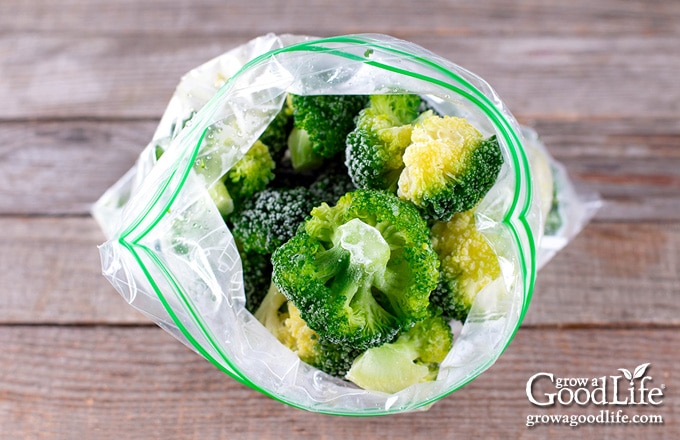
I hope this guide helps you gain the confidence to grow delicious broccoli at home. By following these tips, you will soon enjoy the taste of homegrown broccoli. Happy gardening and may your broccoli harvest be abundant and delicious!
Good planning is key to a successful vegetable garden
Whether you are new to growing your own food or have been growing a vegetable garden for years, you will benefit from some planning each year. You will find everything you need to organize and plan your vegetable garden in my PDF eBook, Grow a Good Life Guide to Planning Your Vegetable Garden.

